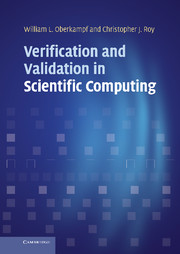Part I - Fundamental concepts
Published online by Cambridge University Press: 05 March 2013
Summary
Chapter 2, Fundamental Concepts and Terminology and Chapter 3, Modeling and Computational Simulation form the foundation of the book. These chapters are recommended reading for individuals interested in any aspect of verification and validation (V&V) of mathematical models and scientific computing simulations. In Chapter 2, all of the key terms are defined and discussed. The chapter is much more than a glossary because it describes the development of the terminology and the underlying philosophical principles of each concept. The reader may be surprised that this chapter is devoted to fundamental concepts and terminology; however, understanding the underlying concepts is critical because many of the terms (e.g., verification, validation, predictive capability, calibration, uncertainty, and error) have a common language meaning that is imprecise and some terms are even contradictory from one technical field to another. One of the exciting aspects of the new field of V&V is that all of the principles developed must be applicable to any field of scientific computing, and even beyond. This is also challenging, and at times frustrating, because the terminology from various technical fields can be at odds with the terminology that is developing in the field of V&V. The discussion presents clear arguments why the concepts and terminology are logical and useable in real applications of scientific computing. Chapter 2 closes with an in-depth discussion of a framework of how all of the aspects of V&V and predictive capability are related and sequentially accomplished.
- Type
- Chapter
- Information
- Verification and Validation in Scientific Computing , pp. 19 - 20Publisher: Cambridge University PressPrint publication year: 2010

